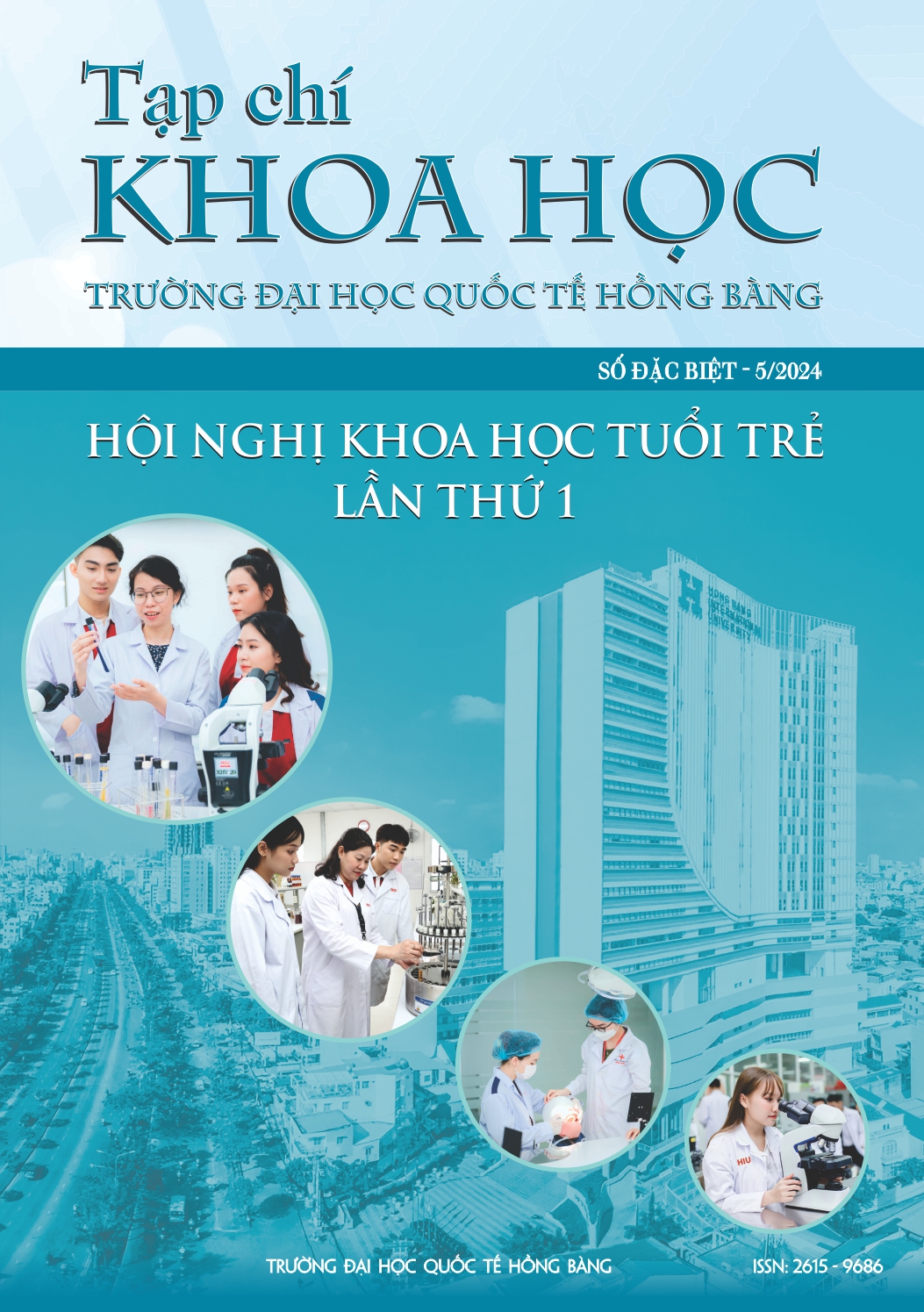BÀO CHẾ VÀ ĐÁNH GIÁ TÁC DỤNG ỨC CHẾ ENZYME α – GLUCOSIDASE IN VITRO CỦA CAO LÁ VỐI (SYZYGIUM NERVOSUM, MYRTACEAE)
Các tác giả
DOI: https://doi.org/10.59294/HIUJS.KHTT.2024.036Từ khóa:
Lá vối, Syzygium nervosum, Myrtaceae, Flavonoid, Kháng khuẩn, α- glucosidaseTóm tắt
Mục tiêu: Xây dựng được quy trình bào chế cao lá vối (Syzygium nervosum, Myrtaceae) giàu flavonoid, đánh giá tác dụng ức chế enzyme α- glucosidase và kháng khuẩn in vitro của cao lá vối. Phương pháp nghiên cứu: Lá vối được sấy khô, nghiền thành bột có kích thước tối đa 0.5 mm và chiết có hỗ trợ siêu âm với các thông số khảo sát như: dung môi, nhiệt độ, thời gian, tỷ lệ dung môi/ dược liệu. Hoạt tính kháng α-glucosidase được đánh giá bằng phương pháp sử dụng cơ chất pNPG. Hoạt tính kháng khuẩn được đánh giá bằng phương pháp pha loãng trong thạch. Kết quả: Xây dựng được quy trình bào chế cao lá vối giàu flavonoid (276.3 ± 5.0 mg RE/g) bằng phương pháp siêu âm với dung môi ethanol-nước 40 %, nhiệt độ 80 °C, thời gian 90 phút, tỷ lệ dung môi/dược liệu (1/20 g/mL). Cao lá vối có khả năng ức chế α-glucosidase với IC50 là 2.2 µg/mL. Cao lá vối thể hiện khả năng kháng khuẩn trên các dòng vi khuẩn Gram dương Streptococcus pyogenes, Staphylococcus aureus, và Bacillus subtilis (MIC lần lượt là 1.95, 125, 500 µg/mL), và Gram âm Escherichia coli, Pseudomonas aeruginosa, và Salmonella typhi (MIC đều là 1000 µg/mL). Kết luận: Nghiên cứu đã xây dựng quy trình bào chế cao lá vối giàu flavonoid, đồng thời đánh giá tác dụng ức chế enzyme α- glucosidase và khả năng kháng khuẩn của cao lá vối thu được.
Abstract
Objective: Develop a process for preparing the flavonoid-rich Voi leaf extract (Syzygium nervosum, Myrtaceae), then evaluate the α-glucosidase inhibitory effect and in vitro antibacterial activity of the extract. Method: The Syzygium nervosum leaves were dried, ground and extracted by ultrasound assisted extraction with investigated parameters such as: solvent, temperature, time, and the sample to solvent ratio. Anti-α-glucosidase activity was evaluated using the pNPG substrate method. The antibacteria activity was assessed by agar dilution method. Results: Developed a process for preparing flavonoid-rich guava leaf extract (276.3 ± 5.0 mg RE/g) using ultrasound method with 40% ethanol-water solvent, 80 °C, 90 minutes, and the sample to solvent ratio of 1/20 g/mL. Syzygium nervosum leaves leaf extract has the ability to inhibit α-glucosidase with an IC50 of 2.2 µg/mL. The extract perform antibacteria activity on Gram positive bacteria Streptococcus pyogenes, Staphylococcus aureus, and Bacillus subtilis (MIC are 1.95, 125, 500 µg/mL, respectively), and Gram negative bacteria Escherichia coli, Pseudomonas aeruginosa, and Salmonella typhi (MIC = 1000 µg/mL). Conclusion: The study has developed a process for preparing flavonoid-rich Syzygium nervosum leaf extract while evaluating its α-glucosidase inhibitory effect and antibacteria activity.
Tài liệu tham khảo
[1] V. Đ. Hải, "Nghiên cứu đặc điểm tái sinh tự nhiên vối thuốc (Schima wallichii Choisy) tại vùng Tây Bắc," Tạp chí NN và PTMT, vol. Số 4. pp. 72-76. 2008.
[2] Đ. T. Lợi, Những cây thuốc và vị thuốc Việt Nam. Nhà xuất bản Y học, 2006.
[3] G. N. Pham, T. T. T. Nguyen, and H. Nguyen-Ngoc, "Ethnopharmacology, phytochemistry, and pharmacology of Syzygium nervosum," Evidence-Based Complementary Alternative Medicine, vol. 2020. 2020.
DOI: https://doi.org/10.1155/2020/8263670[4] T.-T. Dao et al., "C-methylated flavonoids from Cleistocalyx operculatus and their inhibitory effects on novel influenza A (H1N1) neuraminidase," Journal of natural products, vol. 73. no. 10. pp. 1636-1642. 2010.
DOI: https://doi.org/10.1021/np1002753[5] B.-S. Min, C. Van Thu, N. T. Dat, N. H. Dang, H.-S. Jang, and T. M. Hung, "Antioxidative flavonoids from Cleistocalyx operculatus buds," Chemical Pharmaceutical Bulletin, vol. 56. no. 12. pp. 1725-1728. 2008.
DOI: https://doi.org/10.1248/cpb.56.1725[6] P. C. H. Hollman and I. C. W. Arts, "Flavonols, flavones and flavanols–nature, occurrence and dietary burden," Journal of the Science of Food Agriculture, vol. 80. no. 7. pp. 1081-1093. 2000.
DOI: https://doi.org/10.1002/(SICI)1097-0010(20000515)80:7<1081::AID-JSFA566>3.0.CO;2-G[7] E. Barber, M. J. Houghton, and G. Williamson, "Flavonoids as human intestinal α-glucosidase inhibitors," Foods, vol. 10. no. 8. p. 1939. 2021.
DOI: https://doi.org/10.3390/foods10081939[8] A. Ceriello et al., "Postprandial hyperglycaemia and cardiovascular complications of diabetes: an update," Nutrition, metabolism cardiovascular diseases, vol. 16. no. 7. pp. 453-456. 2006.
DOI: https://doi.org/10.1016/j.numecd.2006.05.006[9] T. Wilke et al., "Epidemiology of urinary tract infections in type 2 diabetes mellitus patients: An analysis based on a large sample of 456.586 German T2DM patients," Journal of Diabetes its Complications, vol. 29. no. 8. pp. 1015-1023. 2015.
DOI: https://doi.org/10.1016/j.jdiacomp.2015.08.021[10] S. Kumar, S. Narwal, V. Kumar, and O. Prakash, "α-glucosidase inhibitors from plants: A natural approach to treat diabetes," Pharmacognosy reviews, vol. 5. no. 9. p. 19. 2011.
DOI: https://doi.org/10.4103/0973-7847.79096[11] R. Tundis, M. R. Loizzo, and F. Menichini, "Natural products as α-amylase and α-glucosidase inhibitors and their hypoglycaemic potential in the treatment of diabetes: an update," Mini reviews in medicinal chemistry, vol. 10. no. 4. pp. 315-331. 2010.
DOI: https://doi.org/10.2174/138955710791331007[12] M. N. Qaisar, B. A. Chaudhary, M. U. Sajid, and N. Hussain, "Evaluation of α-glucosidase inhibitory activity of dichloromethane and methanol extracts of Croton bonplandianum Baill," Tropical Journal of Pharmaceutical Research, vol. 13. no. 11. pp. 1833-1836. 2014.
DOI: https://doi.org/10.4314/tjpr.v13i11.9[13] M. M. A. Ranjha et al., "Sonication, a potential technique for extraction of phytoconstituents: A systematic review," Processes, vol. 9. no. 8. p. 1406. 2021.
DOI: https://doi.org/10.3390/pr9081406[14] N. K. T. Linh and N. T. N. Trâm, "Xây dựng phương pháp định lượng flavonoid toàn phần trong dịch chiết lá vối (Cleistocalyx Operculatus) bằng quang phổ UV-VIS," Tạp chí Y Dược học quân sự, vol. 47. no. 4. pp. 5-17. 2022.
DOI: https://doi.org/10.56535/jmpm.V2022050401Tải xuống
Tải xuống: 316











